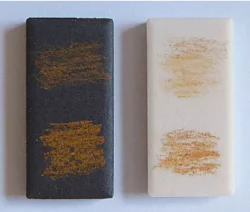Streak Plates
:max_bytes(150000):strip_icc():format(webp)/streakplates-58b5a6693df78cdcd887cbe5.jpg)
A mineral’s streak is the color it has when ground to a powder. Some minerals that occur in a range of colors always have the same streak. As a result, streak is considered a more stable indicator than the color of the solid rock. While most minerals have a white streak, a few well-known minerals can be identified by the color of their streak.
The simplest way to make a powder from a mineral sample is to grind the mineral on a small rectangular piece of unglazed ceramic called a streak plate. Streak plates have a Mohs hardness of around 7, but be sure to check your streak plate against a piece of quartz (hardness 7) because some are softer and some harder. The streak plates shown here have a hardness of 7.5. An old kitchen tile or even a sidewalk can also serve as a streak plate. Mineral streaks can usually be wiped off easily with a fingertip.
Streak plates come in white and black. The default is white, but black can be handy as a second option.
The Typical White Streak
:max_bytes(150000):strip_icc():format(webp)/streakwhite-58b5a69f5f9b58604697ccd5.jpg)
The great majority of minerals have a white streak. This is the streak of gypsum but resembles streaks from many other minerals.
Beware of Scratches
:max_bytes(150000):strip_icc():format(webp)/streakscratched-58b5a6973df78cdcd8885d93.jpg)
Corundum leaves a white streak (left), but after wiping (right) it is clear that the plate itself was scratched by the hardness-9 mineral.
Identifying Native Metals by Streak
:max_bytes(150000):strip_icc():format(webp)/streakAuPtCu-58b5a6913df78cdcd8884b1d.jpg)
Gold (top), platinum (middle) and copper (bottom) have characteristic streak colors, best seen on a black streak plate.
Cinnabar and Hematite Streaks
:max_bytes(150000):strip_icc():format(webp)/streakcinnhem-58b5a68b5f9b586046979012.jpg)
Cinnabar (top) and hematite (bottom) have distinctive streaks, even though the minerals may have drab or black colors.
Identifying Galena by Streak
:max_bytes(150000):strip_icc():format(webp)/streakgalena-58b5a6865f9b5860469781f0.jpg)
Galena may resemble hematite in color, but it has a dark gray rather than the red-brown streak.
Identifying Magnetite by Streak
:max_bytes(150000):strip_icc():format(webp)/streakmagnetite-58b5a67f3df78cdcd88812ee.jpg)
The black streak of magnetite is even visible on the black streak plate.
Streak of Copper Sulfide Minerals
:max_bytes(150000):strip_icc():format(webp)/streakpyrchalcborn-58b5a6763df78cdcd887f83a.jpg)
The copper sulfide minerals pyrite (top), chalcopyrite (middle) and bornite (bottom) have very similar greenish-black streaks. That means you’ll have to identify them by other means.
Goethite and Hematite Streaks
:max_bytes(150000):strip_icc():format(webp)/streak-goethite-hematite-58b5a66f5f9b586046973960.jpg)
Goethite (top) has a yellow-brown streak whereas hematite (bottom) has a reddish-brown streak. When these minerals occur in black specimens, the streak is the best way to tell them apart.
CITE THIS ARTICLE
Alden, Andrew. “How to Use Mineral Streak to Identify Rock Samples.” ThoughtCo, Feb. 16, 2021, thoughtco.com/mineral-streak-examples-4122988.




